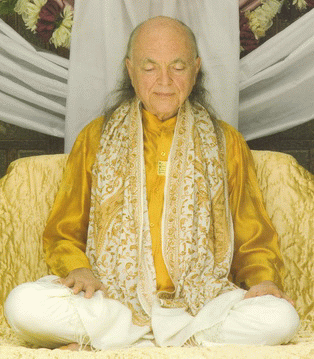
“Right Effort”
A Study by Beezone
of
‘Right Effort’ in the Teachings of Adi Da Samraj

“The Effort Toward (or away from) Union
Has Nothing to Do with Realization of Me”
In the teachings of Buddhism, there is the Eightfold Path (Sanskrit: Astangika-marga), the last of the Four Noble Truths. The Eightfold Path can be divided into three sections; Understanding and Motive, Morality, and Mind Training. Listed individually, the eight areas of practice are: Right Understanding or Views, Right Aims or Motives, Right Speech, Right Action, Right Livelihood, Right Effort, Right Mindfulness, and Right Samadhi.
This study is about one aspect of the Eightfold Path, ‘Right Effort’, as it relates to the teachings of Adi Da Samraj.
An essential element of Adi Da’s teaching involves the real inspection of one’s motivations, intentions, and the manner in which attention is inherently focused – a search, or what he calls “seeking”. Another central, if not the most central, element of Adi Da’s teaching is the matter of putting attention on the Guru. Therefore, ‘effort’, or the movement of energy and attention in the practice of sadhana, is not only basic but at the core of one’s response to Adi Da’s “Call” to “Listen To My Call, and Hear My Voice At Heart, and See My Heart Itself”.
“I am trying to impress you all and everyone who will read this what the process of listening, hearing, and seeing is really all about.
For many, a spiritual path is all too commonly taken up in the manner of “Spiritual Materialism”, a term coined by Chogyam Trungpa Rinpoche. This term refers to how the initial realization, or how one begins a spiritual path, is contaminated by ego, even when the approach or response seems noble. The process then continues, even though progress is corrupted and any realization attained, ego based. ‘Right Effort’, properly understood,
must be distinguished
“The motivated meditator is involved in a process of exclusion and reduction. He is always turning from conditions, sensations, thoughts, etc. toward what is prior to them, what transcends them, what witnesses them, etc. But one who understands no longer turns in this way, for this turning is a part of that which his understanding has penetrated.”
Adi Da Samraj, unpublished notes
THE SUBTLE AND TRANSCENDENTAL REALMS
Since the twentieth century, the cat has been out of the bag. The once cautiously guarded secrets of the esoteric teachings are now touted by every investigator of truth as revelations of their inherently free and natural state. Which paradoxically they are!
We live in a world of mind, where there are only opposites, right and wrong – what Adi Da has referred to as the world of ‘Klik and Klak‘. ‘Right Effort’ is a slippery and easily misunderstood notion which very easily and often does become usurped by ego (self-contraction). {See The Mummery – by Adi Da Samraj}
If you follow my argument, you see it goes into the realm of philosophy, and uses contradictory logic. How can something in time (‘Right Effort”) be out of time? How can one realize something that they are already aware of? This kind of logic can only be understood as a paradox. Paradoxical statements about ‘Right Effort’ point to subtle and transcendental domains of consciousness. In these realms, statements using language (logic) can only be rightly understood when the utterances of the Realizer and ears of the listener are in heart-communion.

EFFORTLESS STATE
A young man from Colombo, Sri Lanka, said to Bhagavan Ramana Maharshi:
YOUNG MAN: J. Krishnamurthi teaches the method of effortless and choiceless awareness as distinct from that of deliberate concentration and effort. Would Sri Bhagavan be pleased to explain how best to practice meditation?
Bhagavan: Effortless and choiceless awareness is our real nature. If we can attain that state and abide in it, that is all right. To do so effort is necessary.
After this exchange, it is reported that Bhagavan Ramana Maharshi quoted some verses from the great Tamil poet and saint, Thayumanavar, the gist of which is as follows:
Though all the scriptures have said it and though we hear it daily from the great ones and even from our Guru, we are never quiet but stray into the world of Maya (illusion) and sense objects. That is why conscious, deliberate effort is needed to attain that effortless state.
Thus, Ramana Maharshi addressed the questioner in his real nature, his choiceless awareness. But then brought up the paradox of having to use effort to achieve a natural effortless state.
EFFORT and EFFORTLESS
The mind is a tool for thinking and therefore the basis of action. For practical purposes, the mind is not only useful but essential for daily living. But what about subtler activities such as meditation or other spiritual disciplines. How should mind or attention be directed by a conscious decision of the mind? Since there is no place to go, isn’t directing one’s mind for the sake of realization akin to what Alan Watts use to refer to as “pulling oneself up by one’s bootstraps”? If it is true, to use another phase from Alan Watts, “Gurus pick your pocket and then sell you your wallet”.
“YOU CAN’T GET THERE FROM HERE”
In the Way of Adidam (The Way of the Heart), Adi Da has continually and seemingly forever
given his devotees the directive to put one’s attention on the Guru.
“To become responsible for the effort that is your self and every aspect of your body-mind is to receive my Blessing, which is always given. Give me your attention at any moment and you will receive this Grace.” – The Adept
“(Your) attention must not be fitful. You must be dissolved, in a constant state of dissolution, Natively. So unsteadiness altogether is what prevents the (real sadhana) – the lack of equanimity, the lack of one-pointedness.
So any preparation for the (sadhana) basically involves all that, purification, steadying, balancing, establishing the asana, the poise of equanimity, or one-pointedness, free of the efforts of attention. So what is happening in your lives as sadhana is the process of release of energy and attention from the things that are binding to you”. – When The Well Never Leaves the View, you are There – Adi Da Samraj, 1996.
These statements surely indicate that the devotee must do something like direct his or her attention (and therefore mind) to an object (of some kind). But, there is a paradox here.
THE PARADOX
The paradoxical problem is that there is no place to go, nothing to achieve – and yet effort and the path exist. The prescription seems simple, though actual realization is not.
Listen to Adi Da instruct his devotee(s) about the blessing she received the night before in a darshan occasion. She is asking about ‘true hearing’, “her effortlessness surrender” and what is required in understanding Ishta-Guru-Bhakti Yoga, the Yoga of turning attention to the Guru.
In his response, Adi Da says, “it is NOT proper to call it effort”. He then continues by saying “effort is not the proper word” to use in her description of her response. But then, in the next sentence, he says, “that doesn’t mean that the word effort is not properly a word to use” and you should just do nothing and wait for something to happen.
Listen to the audio and then consider His ‘no’ then ‘yes’ paradoxical response.

DEVOTEE: I wondered whether what I experienced last night was an intuition of what the yoga of Ishta-Guru-Bhakti is. There was nothing that could distract me from that. And I felt that, if I was somehow brave enough, vulnerable enough to experience that last night in a semi-conscious state, I wondered if True Hearing is something that is based on that level of effortlessness.
ADI DA SAMRAJ: In any moment of true communion that is so. But the practice does involve responsible dealing with yourself. It requires intentional dealing with yourself. But as I said to you the other evening it is not proper to call it effort. Because you do it in the context of devotion to me, response to me. So, effort is not the proper word. But that doesn’t mean that the word effort is not properly the word to use, that you do nothing and wait for it to happen to you. You must exercise yourself rightly and intelligently. Notice what there is to notice that diminishes the fullness of communion with me and change those things intentionally and do those things consistently.
This is definitely required. So don’t call it effort. But don’t presume you’re suppose to wait around for it to happen. It is your obligation. It is the kind of obligation that is there at the very beginning of this Way, not later. It is the foundation.”
DISCRIMINITIVE INTELLEGENCE
“Suffer the paradox instead of the confusion. It will only be a paradox to you if you turn to Me. If you continue to do it yourself, you will be confused.” – Adi Da Samraj, 1975
It is clear in his response that Adi Da is using the term effort in two ways. He says on one hand that effort is not proper and on the other that it is proper.
Adi Da points out that the term effort is not proper because responding to him occurs in a devotional Recognition and in the context of true hearing (self-understanding).
“Do you know what love is?
Why all this effort in life?
Why do we make such an immense effort to do anything?
Please carefully listen.
When you ask that question, “Why all this effort”, then you have to ask: What is love?
Is love effort?
I must love you, therefore I am going to make an effort to enquire, what love is.” – J. Krishnamurti
RIGHT EFFORT
The effort that is proper or right is one of the heart, in consciousness, not of mind alone. The effort of mind alone is always about dilemma, and a strategy for an outcome. It is either wanting to approach someone or something, or it is in the form of an avoidance. The “effort” of the heart, in consciousness, is a feeling matter (tacit) and is therefore much more subtle than logic, mind, or thought.
ATTRACTION
A true response, or right effort, is based on one of the four forms of Recognition in the context of true hearing and in the realization of the inherent dilemma of mind (self), the state of being in a double bind, where the only resort is Grace.
“Turning to Me is not a dissociative strategy. You are not moving away from something and turning to something else. It is not a movement of attention from something to something else. In your presumed practice of turning to Me, you have added the “method” of turning away from what is in the field of view of the faculties. That is not the practice. That is something you are egoistically adding to the practice. Some form of religion. You are applying a willful religious “method” of your own, and not simply resting the faculties in Me. That is the cult. That is narcissus. You have put a priest between yourself and Me. It is your own ego, your own mind. It is performing the practice for you. You must relinquish your association with this priest.” – Adi Da Samraj, September 1, 2004
To understand right effort or turning in the teaching of Adi Da Samraj, one must have the basis of right understanding of egoity. The practitioner needs to understand the practice, the doing of his Instruction, and its ego-transcending basis. To take his instruction as a presumed separate self and try to apply it as you would any other form of teaching is to take Him in his gross form, as if he were only a teacher.
“You can’t set recognition-response aside and reduce this Way to techniques or practices or ideas alone. All of those kinds of content can be fitted into the body-mind in its independence from Me, in its self-contraction. So you may think The Way is about turning the faculties to Me. Yes, it is, but it’s not merely about turning the faculties, it’s about Me, turning the faculties to Me, not merely by objectifying Me into something from which you are detached, but on the basis of the present recognition of Me, knowing of Me” – Adi Da Samraj – April 10, 2005
Relating to Adi Da in his gross form is of course necessary for the beginning, but it’s not anywhere close to the subtle nature of his Call.
RECOGNITION-RESPONSE
“The core of the being is the heart, not the head or the navel, but the heart, the function of feeling-attention, the unobstructed emotional connection, or communion with everything through feeling. That function is the principal one, and the realization of spiritual life depends on that function, on its becoming active. Spiritual practice is about the re-adapting to this feeling function of the heart. – Adi Da Samraj,
After many, many years of teaching, Adi Da Samraj relinquished his teaching demonstration and took his ‘seat’ as a Blessing Power. The teachings had all been given and now he was ‘waiting’ for the response of his devotees. In this new asana the teachings were summerized to a simple admonition of a ‘Recognition-Response’ the heart-turning to Him. This heart-turning is the spontaneous, natural and effortless recognition of Who He Is and What is the natural gesture in that recognition. Of course there are stages to this process and therefore a further understanding is required.

Watch Adi Da Describe what Recognition IS
Also see:
Sutra 14 – Dawn Horse Testament – Beezone Study
Recognition Is the Key to Enlightenment – Adi Da Samraj, 1980
YOU HAVE TO DEAL WITH YOURSELF
The ground and root of Adi Da’s teaching are based on ‘self-understanding’ or ‘right understanding’, which inherently requires a ‘right approach’ based on “right effort.” This approach, based on recognition requires a radical change in ‘point of view’. Why does it require a change in point of view? Because you in your recognition, based on self-understanding, see ‘something’ about not only Who He Is, but who you are, or what Truly IS. This is both a horrifying, heart-breaking and Revelatory Ecstatic vision.
This initial and forever (if allowed to flower) heart recognition is now the basis of your potential response to Who, What and Where He IS. Once this door opens and His Mere Presence Revealed (and the illusion of yours!) there is only one response that can be rightly made.
“The response that is practice…that is what is missing. The teaching itself is whole and complete. The demonstration is whole and complete. The offering is whole and complete.
There really isn’t anything significant to add to it. I can polish a line or two. Close up a loophole here and there. Dot an I. Cross a T here and there. Add a little language here and there you see. Pay attention to a few details and continue to speak and so forth but fundamentally it’s there and there’s nothing I am doing or may do in the future that is going to add significantly to what you’ve already been given.
So your own response is what is missing and the reason why that response is not there in your personal case is something you have to deal with and therefore it is entirely your business.
I’m looking for individuals whose response is serious and effective so that the work that I am can serve those who are responsive. The work that I do is not only what I do but which I AM.
The work will continue by the demonstration of my lifetime for the sake of everyone. Others will have the opportunity to be a demonstration for the sake of all others. They will then see and know that this process is alive and effective. The response is the only thing missing.” – Adi Da Samraj, 1988.
“The real practice is in this “root”-recognition-response to Me, and everything of the Reality-Way of Adidam is the magnification of that. So, that “root”-recognition-response to Me is what every devotee must be involved with moment to moment, and what those who can and should be acknowledged as the renunciates in the Reality-Way of Adidam must exemplify. That is how they are to be measured. It is a profundity measure. It is not a difference of practice measure. It is the sign of profundity of those who most fully do this. They have the fundamental ability, based on that profundity, to serve and guide the gathering of My devotees as an extension of My Person. Without that “root”, moment to moment, true sign, they are insiders only and revisionists, and they are false.” Adi Da Samraj, August 16, 2008.
For more on this see:
HEARING in the teachings of Adi Da Samraj
The Effort Toward Union Has Nothing to Do with Realization of Me
Beezone Study – Transcendence